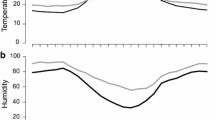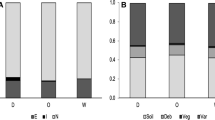Summary
Among the antsCr. scutellaris which form foraging columns in order to exploit their «trophoporic» area (these are aphidicolous ants mostly feeding upon the honeydew discharged by Homoptera) these columns can sometimes extend on a considerable length. In the two examples above mentioned a column covered a distance of 45 metres and another one of 43 metres before they definitively dispersed.
In another speciesCr. auberti (equally pastoral, but keeping rooteating Homoptera) the ants do not progress in columns but run about their «trophoporic» area isolated or in small groups of gatherers. The above-cited experiment shows that the greatest number of the tracks covered is to be found on the surface of the ground (75% of them) but underground tracks are yet to be observed and these are exclusively used in the storage of food and not for any other activity in the general management of the formicary.
Similar content being viewed by others
Author information
Authors and Affiliations
Rights and permissions
About this article
Cite this article
Soulié, J. Notes sur les champs trophoporiques de quelques espèces françaises du genreCremastogaster Lund (Hymenoptera-Formicoidea). Ins. Soc 9, 265–272 (1962). https://doi.org/10.1007/BF02329896
Issue Date:
DOI: https://doi.org/10.1007/BF02329896




